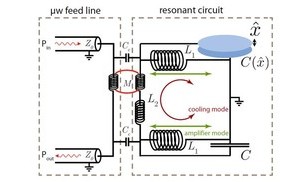Aug 25 2014
EPFL researchers have developed a theoretical method that uses optomechanics to amplify weak signals.
 © 2014 EPFL
© 2014 EPFL
Signal amplification is one of the most common needs in research and technology. But this requires fine-tuning the amount of noise allowed in order to avoid obscuring the actual signal. This fine-tuning becomes problematic when dealing with very weak signals, wherein quantum mechanics imposes an even lower noise limit on the noise that an amplifying device can allow. Therefore, designing amplifiers that can operate at with such low levels of noise is an ongoing challenge in physics, and would also have wide implications for engineering and technology. In a Physical Review Letters publication, EPFL researchers, collaborating with the University of Basel, have put forward a theoretical approach for the design of such an amplifier.
The team of Tobias Kippenberg at EPFL (Laboratory of Photonics & Quantum Measurements), collaborating with a scientist from the University of Basel proposed a theoretical system that can amplify signals with the lowest level of noise. The system consists of nano-mechanical oscillator, in particular a tiny moving drum. As it moves, the mechanical motion of the drum modulates the frequency of two superconducting microwave cavities, which are metallic structures that confine electromagnetic waves in the microwave spectrum.
In the proposed system, microwave photons are confined in one of the microwave cavities are used to restrict the movement of the nano-mechanical oscillator, making it “quiet” enough to eliminate noise caused by temperature fluctuations. The other microwave cavity contains the actual signal to be amplified. The nano-mechanical oscillator amplifies the signal through the interaction between the second cavity and the moving nano-mechanical oscillator. Because the drum is “quiet”, the noise added by the amplification process is limited to the drum’s “zero-point motion”.
Reference
Nunnenkamp A, Sudhir V, Feofanov A, Roulet A, Kippenberg TJ. 2014“Quantum-Limited Amplification and Parametric Instability in the Reversed Dissipation Regime of Cavity Optomechanics”, Physical Review Letters 113, 023604 (2104)
Author: Nik Papageorgiou
Source: SB | Sciences de Base